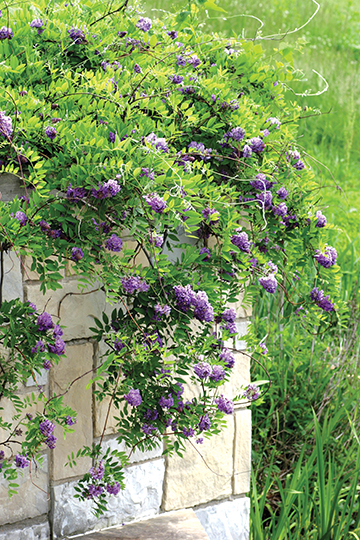KENTUCKY WISTERIA
Kentucky Wisteria merits space in midwest gardens
Wisteria is a genus that can be divisive in the plant world. Their unmistakable blooms can transport you to another land, filled with afternoon tea and romantic whimsy. In the wrong location, wisteria’s long, rambling vines will transport you to the Little Shop of Horrors.
Wisteria is a member of the pea family (Fabaceae). Many genera of this family, like redbud (Cercis canadensis), have edible parts that can be consumed with little preparation. Wisteria is the black sheep when it comes to edibility. Its pods are poisonous and should not be consumed. They redeem themselves by fixing nitrogen in the soil like other leguminous plants.
Many local gardeners have made the change from Chinese wisteria (Wisteria sinensis) to Kentucky wisteria (Wisteria macrostachya) for its reliability in our climate, longer bloom time and lower susceptibility to disease.
One noticeable difference between Chinese and Kentucky wisteria is that our native cultivars bloom later in the season after the vines have “leafed-out.” This ensures that flower buds won’t be damaged by late freezes and frosts and it increases bloom dependability.
The Kentucky wisteria was originally included in the American wisteria (Wisteria frutescens) species. A separation had to be made when it was found that the Kentucky species had longer 6-12 inch blooms, a better cold tolerance and was a slightly less vigorous grower. For wisteria lovers, less vigor is a good thing.
Don’t let the description fool you, all wisteria will still need a sturdy structure and room to grow. With the proper site selection and pruning, Kentucky wisteria can bloom three times in a season.
Gardeners can get into trouble by planting wisteria on an arbor attached to their house. This is where unruly wisteria gets a bad name and gardeners get overwhelmed. A better location, would be something not attached to a home or dwelling. A few good site examples are a chain-link fence, a sturdy arbor or an unsightly cinderblock wall. Anything that will support and allow a vine to grow up to 25 feet in length will work.
Kentucky wisteria prefers to be grown in full sun with medium soil fertility and moisture. Keep this in mind during the fall season. If there is too little moisture in autumn, it could drastically decrease the flower quantity for the next year.
Prune Kentucky wisteria after bloom time or in the winter, and don’t go overboard. Too much pruning will overstimulate this plant and you will get more vine and fewer flowers. Other wisteria species are better suited to create wisteria trees and tolerate heavy pruning. This is the vine that you grow if you want to cover something ugly with something delightfully stunning.
Kentucky wisteria is native to the southcentral United States. Its range can be found reaching up into the bootheel of Missouri. So even though it isn’t naturally occurring in Kansas City, it is considered a native to our state.
Like many Midwestern native plants, Kentucky wisteria is important in the lives of beneficial insects. The showy, lilac-blue flowers provide pollen to bees and the leaves are known to be a host for the larva of the silver-spotted skipper butterfly (Epargyreus clarus).
The Kentucky wisteria cultivar ‘Blue Moon’ is one of the quickest to bloom, sometimes after only two years of growth. This is much faster than Chinese wisteria which can average five or more years before flowering is expected. ‘Blue Moon’ has also been bred to tolerate winters with temperatures as low as -40 degrees F.
With local origins, ‘Powell Purple’ is the variety of Kentucky wisteria planted at the Ewing and Muriel Kauffman Memorial Garden. Powell Gardens’ previous head of horticulture, Alan Branhagen, took cuttings from a unique wisteria that he found growing close to an abandoned farmhouse near Blue Springs. Garden guests seem to be just as impressed with the gnarled, twisting trunks climbing the walls, as they are with the delicate blossoms.
Kentucky wisteria is a plant that gives year round interest to the Kansas City garden. With the proper space and care, it will give years of pleasure to your outdoor world.
Tracy Flowers is on the Horticulture staff at Powell Gardens and she works at The Ewing and Muriel Kauffman Memorial Garden. You may reach her at 816-932-1200.
To view additional images of Wisteria, visit the online version of the May 2017 issue at KCGMAG.com.

